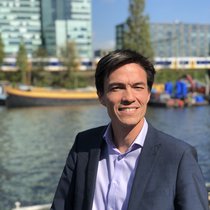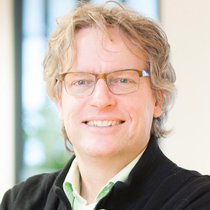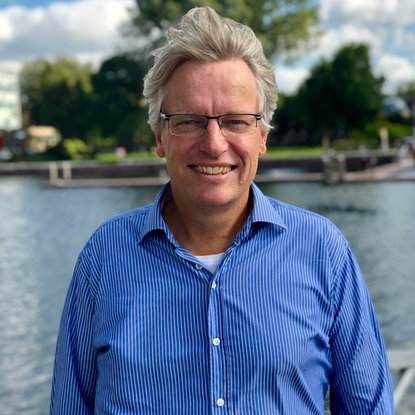About the MSc MADE Living Lab
The Living Lab course is part of the MSc MADE graduation year. During the living lab course, MSc MADE students work together with partners from the city and AMS Institute's network on solutions for a wide range of urban challenges. Allowing them to gain Living Lab experience on various urban challenges in a real-life setting. They work from an interdisciplinary approach, and with their projects they design solutions to contribute to a sustainable and liveable city.
“These students are true entrepreneurs. Kicking off the MADE master as the first cohort of students, as well as the way they worked on their living lab assignments to create innovative solutions for the real-life challenges of the city of Amsterdam.”
Kenneth Heijns
Former Managing Director at AMS Institute

Living lab DGTL - Illuminating NDSM
The NDSM-Werf is a dark area and has many broken streetlights. Stakeholders describe the area as unsafe and feel that there is a bad atmosphere at night. After discussions with residents, entrepreneurs, experts, DGTL festival and the NDSM-Werf Foundation, the MSc MADE students decided to develop an innovative and functional plan for the street lighting at the former shipyard.
Students came up with the idea to develop two multifunctional spots. These movable light objects serve as atmospheric lighting during DGTL festival and shine in different colours on the festival grounds. Creating a better lighted area and contributing to the safety of the area.
The light objects are designed by the artist Paul Timmer, who is based in the NDSM-Loods. The material was supplied by Stadshout, an initiative that seeks sustainable applications for the timber harvest from Amsterdam. As a result, the students created a very sustainable solution for the many broken street lights in the area.
The 4.5m tall light objects were presented during DGTL Festival on Saturday 20 and Sunday 21 April 2019. After DGTL Festival, the light objects will remain available for future events on-site. In the future, these light objects might form the basis for a total lighting plan that suits the character of the site. The project attracted a lot of interest, from media requests to inquiries from city officials.
Project members: Carola Raaijmakers, Koen Kaljee, Marijke Rommelse
Partners: DGTL Festival, Stichting NDSM, Paul Timmer (designer & builder), Local entrepreneurs and citizens
Concretely circular
Concrete is one of the largest waste streams. Currently, most concrete waste in the Netherlands is ‘downcycled’ and used as a foundation for roads and infrastructure. It is interesting to look into the potential to recycle concrete to products with a higher value, upgrading the value of the concrete in the value chain.
To understand the concrete waste streams in the Amsterdam Metropolitan Area the concept of value chains was at centre stage in the students’ research process. Value chains are used to describe how value is created along with material flows, taking into account the interplay of the actors and their stakes, the economic value of the material, activities that take place, as well as broader socio-economic and environmental factors. Such a multi-level understanding of the concrete sector helps identify impact points to increase circular use of concrete.
To experiment with the outcomes of their study, students developed their own concrete designs, such as a table tennis table. The designs the students made will be realized for Marineterrein Amsterdam. This way the upcycled concrete can provide a valuable contribution to public space. Next to the designs the students also developed a website and a board game to contribute to the process of circular decision making for stakeholders in the concrete industry.
Project Members: Gwenhwyfar Spil, Anthony Meijer and Toni Kuhlmann
Partners: KplusV, TUDelft, AMS Institute, Bureau Marineterrein, Rutte Groep, Tomaello and Candido
Implementing sustainability and circularity in Haven-Stad
In June 2017, the Amsterdam city council presented the plans to develop a new district in Amsterdam: Haven-Stad, a new residential area that combines working and living. To facilitate the process of transforming the area from an industrial area and business park to a sustainable and circular area in a co-creative manner, a strong decision-making process should be in place at the start of the re-development of the area. Students developed two products to improve the process of co-creation:
- A toolbox and a roadmap showing what ingredients are needed in such a process and which steps have to be taken. The roadmap can be used by policy-makers, designers and project leaders to implement co-creation and stimulate a process based on a level playing field.
- A method to facilitate the transition to circularity: which steps should you take and what should be in place to stimulate a successful transition.
Project members: Anne Kok & Martijn van Stam
Partners: Amsterdam Municipality (project bureau Sloterdijk 1 Zuid)
WASCOM: urban waste to urban material
In a circular society waste streams are efficiently recycled and upcycled. This also holds true for waste streams from wastewater treatment plants. Unfortunately, it still is common practice in the Netherlands to digest or incinerate these streams. However, these residual streams can be used to produce a high-value lightweight bio-composite material. Cellulose and ALE can be combined to yield a lightweight bio-composite material that can be applied in, for instance, the transport or building sector. In this living lab, the goal of the students was to develop a product with an urban application from a new material (WASCOM) developed out of waste water flows from the city. Their prototype result was a flower planter. They made a cool registration of the process.
Project members: Mike Schroten, Laurens van der Wal, Moja Reus, Sya Hoeke, Nono Leermakers
Partners: WASCOM consortium, including the partner organizations NPSP (case owner), Chaincraft, Waternet and TU Delft ; Students have followed a course at Industrial Design at TU Delft and thereby adopted the Material Driven Design approach developed by Elvin Karana; furthermore, a range of co-creation sessions was done together with actors from the private and public sector, civil society and knowledge institutes.
Creating incentives for local renewable energy organizations
Local Renewable Energy Organizations (LREO’s) increasingly emerge as decentral renewable energy producers on a neighbourhood, district, city or national level. In 2018 a total of 484 LREOs were active in the Netherlands, which is a 20% increase from 2017. A positive development that contributes to the energy transition. Also in Amsterdam LREOs are of great value for the energy transition. This Living Lab focused on how the cooperation with LREOs in Amsterdam could be improved and how they can add value to the Amsterdam Climate Agreement.
Two products have been developed: an online platform (website) and an advice rapport. Do's and don'ts are identified for the municipality of Amsterdam in relation to the Amsterdam Climate Agreement when using an online platform and how LREOs can be valuable contributors.
Project member: Marjolein ten Haaft
Partners: Municipality of Amsterdam (case owner), Firan, Green Choice, Zuiderlicht, Windvogel, NDSM Energie, Zon op Zeeburg, Groen Gas Gaasperdam, VvE Lindengracht & Accenture (internship)
Guide to talking trash
We bring our textiles to special bins, to give them a second life in vintage stores or in developing countries. As the textile industry in these countries has developed, there is less need for textile streams from abroad. The project looked into a way to create better local use of post-consumer textile waste, saving transportation and creating circular fashion innovation. The results are a process for a living lab way of working and a design theory that can be applied in the area of (local) circular fashion innovation.
Project member: Dieuwertje Wagenaar
Partners: Gemeente Amsterdam, Fashion for Good and Sympany
A roadmap to the Inspirational Demonstration Garden in the Amsterdam ‘West-Indische buurt’
The ‘West-Indische buurt in Transitie’, an Amsterdam neighbourhood initiative, focuses on making the neighbourhood more sustainable, as the area has a low amount of greenery and is a known bottleneck according to Amsterdam Rainproof. The demonstration garden showcases various innovations that can be implemented to make the area more rainproof, improving the climate resilience of the area. Innovations include among others hydrophyllic vegetation, a wade, a rain water pond and a greenhouse.
The garden group – a sub group of the initiative – is about to complete an inspiring demonstration garden. In the project a roadmap was developed that shows the steps and parties involved to realize this special project. The roadmap can be used as an example for future initiatives.
Project member: Brian Wals
Partners: Amsterdam Rainproof, AMS Institute, The Green Village, Hoogheemraadschap van Delfland, Eigen Haard, Gemeente Amsterdam, West-Indische buurt in Transitie’ and Atelier Groenblauw.
Go wild: talk to someone
There is an excessive waste problem on the streets of the Amsterdam Venserpolder district. Although the project started with the ambition to find human-centered design solutions, it soon became clear that the issue wasn’t in creating better design solutions, but in better communication. Better communication between the municipality, citizens and groups with different interests on a neighbourhood level. The project result was a storytelling model in which there is attention for many factors we often forget when we are immersed in our own bubbles. Subtle factors that can make a huge difference for impact and results. Factors such as the importance of attitude, language, visual representation and interaction and presentation skills throughout the process. The manual was topped with a complementary tool the ‘bolderkar’, to be used as a means to start the conversation.
Project member: Anna Boogaard
Partners: PKYGRND City, Hoodlab ZuidOost and Gemeente Amsterdam
“Our students can be very proud of the challenges they tackled and the products they’ve delivered. It has been an amazing living lab journey to witness!”
Toine Andernach, Living Lab Course Coordinator

An overview of where in Amsterdam all the Living Lab activities took place
All projects are part of the Living Lab course of the master Metropolitan Analysis, Design and Engineering (MSc MADE), a joint degree master of Wageningen University and Research and Delft University of Technology. In terms of topics and content, the master's is closely linked to the activities of AMS Institute, home for the students and the MSc MADE education activities.
